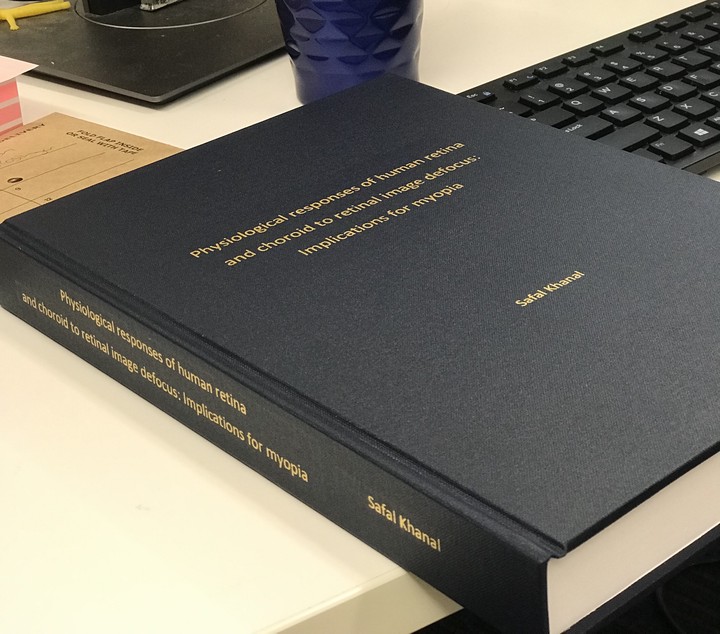Physiological responses of human retina and choroid to retinal image defocus, Implications for myopia

Abstract
Background. Refractive development is visually guided by local regulation of eye growth. The retina and choroid have been implicated in detecting defocus and relaying information to the sclera to control eye size and thus maintain emmetropia. However, the mechanisms underlying retinal and choroidal responses to defocus remain unclear. Aims, To quantify and localise electrophysiological responses of the retina to optical defocus, and to investigate alterations in blood perfusion as a potential mechanism underlying changes in choroidal thickness in response to retinal image defocus. Methods. Experiment (1), Nineteen healthy young adults (age, 23 ± 3.5 years, spherical equivalent refraction (SER), +0.25 to -4.50 D) underwent global flash multifocal electroretinogram (gmfERG) testing under three lens-imposed defocus conditions (2.00 D myopic, 2.00 D hyperopic, and no defocus). Recordings were made monocularly before and 24 hours after administration of one drop of the myopia-inhibiting agent atropine 0.1%. Signals reflecting outer (direct component, DC) and inner (induced component, IC) retinal activity were analysed in central 6 degrees and peripheral (6 to 24 degrees) retinal zones. Experiment (2), Twenty healthy young adults (age, 25 ± 5 years, SER, +0.50 to -3.00 D) were scanned by 3T SKYRA MRI twice within a single session repeated at the same time of day in two visits. A non-invasive arterial spin labelling MRI (ASL-MRI) technique was optimised to image chorio-retinal blood perfusion in both eyes by magnetically labelling the blood. Experiment (3), In a clinical trial, thirty healthy young adults (age, 25 ± 4 years, SER, +2.00 to -3.00 D) underwent ASL-MRI after viewing a distant target (video-movie) for 40 minutes in a supine position in two randomised visits (within a week). At one visit (experimental visit), one randomly chosen experimental eye received 2.00 D myopic defocus while the fellow control eye received no defocus. At the other visit (control visit), both eyes of the subjects were optimally corrected for the viewing distance. Results. Experiment 1, Imposed optical defocus had a significant effect on inner retinal electrophysiology responses, with greater IC amplitudes for myopic defocus compared to hyperopic and no defocus, in both the central zone (F(2, 36) = 4.04, p = .03) and the peripheral zone (F(2, 36) = 26.2, p < .001). Twenty-four hours after atropine instillation, the IC amplitude responses to myopic defocus significantly increased, without changes in the responses to hyperopic and no defocus (F(2, 36) = 6.05, p = .01). This differential effect of atropine on electrophysiology responses to defocus was evident only for the IC response in the peripheral retinal zone. Experiment 2, Quantitative ASL-MRI measurements of chorio-retinal blood perfusion demonstrated high intra- (r = .95, 95% CI [.88, .98], p < .001) and inter-visit repeatability (r = .80 [.58, .91], p < .001). Chorio-retinal perfusion measures were not different between sessions within the same visit (mean [95% CI] difference of +2.69 [+16.9, -22.2] ml/100ml/min, p = .24) and between visits (-7.44 [+27.5, -42.3] ml/100ml/min, p = .08). Experiment 3, In the clinical trial, baseline measures of perfusion under no imposed defocus were not significantly different between the control and the experimental eye (median, 64.2 vs 62.3 ml/100ml/min, median difference (MD) = -0.05 [-6.66, +6.28], Wilcoxon p = .95). No significant changes in perfusion were observed for the control eye (MD = +6.95 [-9.51, +17.3], p = .15) or the experimental eye (MD = +2.32 [-4.92, +16.8], p = .20) between the visits (i.e. experimental - control visit). Changes in perfusion between the visits were also not different between the control and the experimental eye (MD = -1.69 [-13.8, +7.49], p = .69). Conclusions. 1) Imposed optical defocus caused an increase in the IC amplitudes in the peripheral retina; this increment in the IC amplitudes was further enhanced by the use of atropine while under myopic defocus, without affecting responses to hyperopic and no defocus. These results suggest that the inner layers of the peripheral retina may be involved in detecting the sign of defocus and processing defocus signals related to axial eye growth and myopia. 2) Quantitative ASL-MRI measures of chorio-retinal perfusion demonstrated high intra- and inter-visit repeatability, indicating that the ASL-MRI technique, when optimised for ocular application, provides a method of obtaining reliable measures of chorio-retinal perfusion in vivo. 3) Short-term imposed myopic retinal defocus did not affect chorio-retinal perfusion measured with ASL-MRI, suggesting that changes in perfusion may not be responsible for the changes in choroidal thickness previously reported by others during imposed optical defocus.